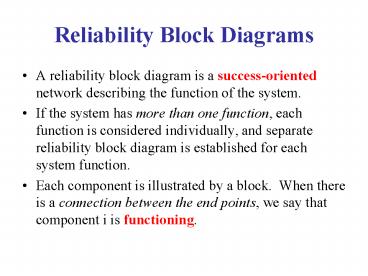Reliability Block Diagrams - PowerPoint PPT Presentation
1 / 48
Title:
Reliability Block Diagrams
Description:
If the system has more than one function, each function is considered ... We obtain a better system by introducing redundancy at component level than by ... – PowerPoint PPT presentation
Number of Views:680
Avg rating:5.0/5.0
Title: Reliability Block Diagrams
1
Reliability Block Diagrams
- A reliability block diagram is a success-oriented
network describing the function of the system. - If the system has more than one function, each
function is considered individually, and separate
reliability block diagram is established for each
system function. - Each component is illustrated by a block. When
there is a connection between the end points, we
say that component i is functioning.
2
(No Transcript)
3
(No Transcript)
4
Example
- Consider a pipeline with two independent safety
valves that are physically installed in series.
These valves are supplied with a spring-loaded,
fail-safe, close by hydraulic actuator. The
valves are opened and held open by hydraulic
control pressure and is closed automatically by
spring force whenever the control pressure is
removed or lost. In normal operation both valves
are held open. The main function of the valves
is to act as a safety barrier, i.e., to close and
stop the flow in the pipeline in case of an
emergency.
5
(No Transcript)
6
(No Transcript)
7
Example
- It is usually an easy task to convert a fault
tree to a reliability block diagram. In this
conversion, we start from the top event and
replace the gate successfully. An OR-gate is
replaced by a series structure of the
components directly beneath the gate, and an
AND-gate is replaced by a parallel structure of
the components directly beneath the gate.
8
(No Transcript)
9
(No Transcript)
10
Structure Function
- The state of component i can be described by a
binary state variable, i.e., - Similarly the state of a system can be described
by a binary function
11
Series and Parallel Structures
- Series
- Parallel
12
k-out-of-n Structure
13
2-out-of-3 Structure
14
Coherent Structures
- Definition A system is said to be coherent if
all its components are relevant and the structure
function is non-decreasing in each argument. - Relevant
- Irrelevant
- Non-decreasing structure function
15
Definitions
16
Example
- Component 2 is irrelevant
1
2
a
b
1
17
Some Theorems for Coherent Structures
18
Redundancy at System Level
19
Redundancy at Component Level
We obtain a better system by introducing
redundancy at component level than by introducing
redundancy at system level.
20
Path Sets and Cut Sets
- A structure of order n consists of n components
numbered from 1 to n. The set of all components
is denoted by C. - A path set P is a set of components in C which by
functioning ensures that the system is
functioning. A path set is said to be minimal if
it cannot be reduced without loosing its status
as a path set. - A cut set K is a set of components in C which by
failing causes that the system to fail. A cut
set is said to be minimal if it cannot be reduced
without loosing its status as a cut set.
21
(No Transcript)
22
Example 1
23
(No Transcript)
24
Example 2
25
Structures Represented by Paths
26
Example 2
27
(No Transcript)
28
Structures Represented by Cuts
29
Example 2
30
(No Transcript)
31
Critical Path
- A critical path vector for component i is a state
vector - Such that
- A critical path set corresponding to the critical
path vector for component i is defined by
32
Structural Importance
33
Example
- Consider 2-out-of-3 structure
34
Example
35
Pivotal Decomposition
36
Example Bridge Structure
37
(No Transcript)
38
(No Transcript)
39
Structure of Composed Components
- Partition into subsystems is done in such a way
that each component never appears within more
than one of the subsystems.
40
(No Transcript)
41
Some Notations
42
Coherent Modules
- Let the coherent structure be given,
and let - Then is said to be a coherent module
of - if can be written as a function
- where is the structure function of a
coherent system. - What we actually do here is to consider all the
components with the index belonging to A as one
component with state variable . When
we interpret the system in this way, the
structure function can be written as
43
(No Transcript)
44
Example
45
Modular Decomposition
- A modular decomposition of a coherent structure
is a set of disjoint modules together with an
organizing structure such that
46
Prime Module
- A module that cannot be partitioned into smaller
modules without letting each component represent
a module, is called a prime module. - III represents a prime module. II is not since it
may be described in Fig 3.35 and hence can be
partitioned into IIa and IIb.
47
(No Transcript)
48
(No Transcript)































